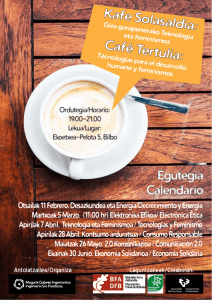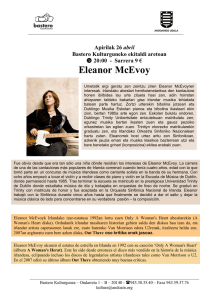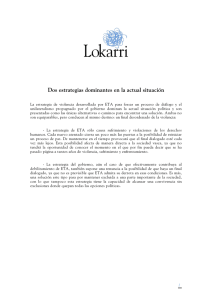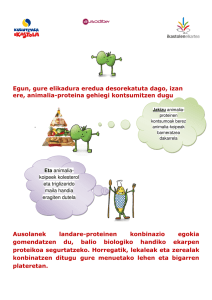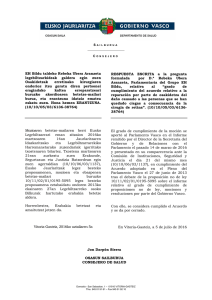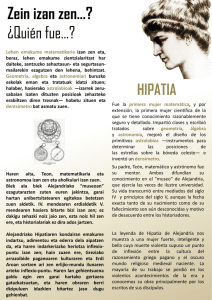juan sebastian elcano
Anuncio
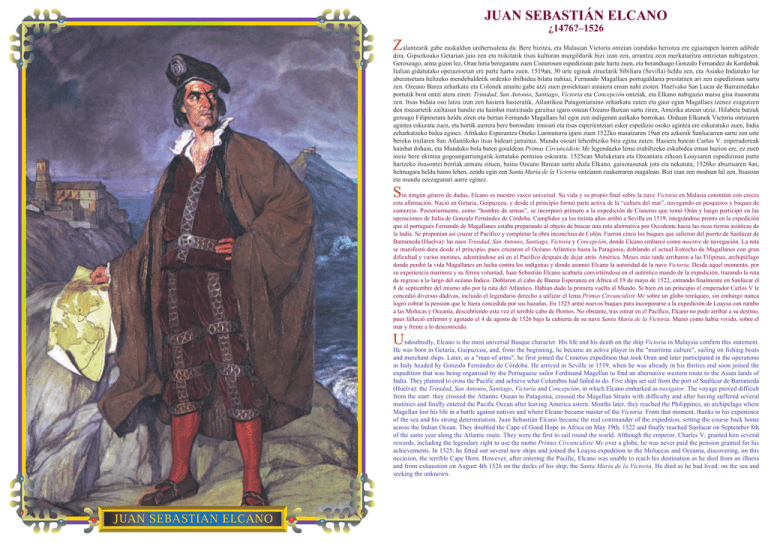
JUAN SEBASTIÁN ELCANO ¿1476?–1526 Z alantzarik gabe euskaldun unibertsalena da. Bere bizitza, eta Malasian Victoria ontzian izandako heriotza ere egiaztapen horren adibide dira. Gipuzkoako Getarian jaio zen eta txikitatik itsas kulturan murgildurik bizi izan zen, arrantza zein merkataritza ontzietan nabigatzen. Geroxeago, arma gizon lez, Oran hiria bereganatu zuen Cisnerosen espedizioan pate hartu zuen, eta beranduago Gonzalo Fernandez de Kordobak Italian gidatutako operazioetan ere parte hartu zuen. 1519an, 30 urte eginak zituelarik Sibiliara (Sevilla) heldu zen, eta Asiako Indiatako lur aberatsetara heltzeko mendebaldetik ordezko ibilbidea bilatu nahiaz, Fernando Magallaes portugaldarra prestatzen ari zen espedizioan sartu zen. Ozeano Barea zeharkatu eta Colonek amaitu gabe utzi zuen proiektuari amaiera eman nahi zioten. Huelvako San Lucar de Barramedako portutik bost ontzi atera ziren: Trinidad, San Antonio, Santiago, Victoria eta Concepción ontziak, eta Elkano nabigazio maisu gisa itsasoratu zen. Itsas bidaia oso latza izan zen hasiera hasieratik, Atlantikoa Patagoniaraino zeharkatu zuten eta gaur egun Magallaes izenez ezagutzen den itsasartetik zailtasun handiz eta hainbat matxinada garaituz igaro ostean Ozeano Barean sartu ziren, Amerika atzean utziz. Hilabete batzuk geroago Filipinetara heldu ziren eta bertan Fernando Magallaes hil egin zen indigenen aurkako borrokan. Orduan Elkanok Victoria ontziaren agintea eskuratu zuen, eta hortik aurrera bere borondate irmoari eta itsas esperientziari esker espedizio osoko agintea ere eskuratuko zuen, India zeharkatzeko bidea eginez. Afrikako Esperantza Oneko Lurmuturra igaro zuen 1522ko maiatzaren 19an eta azkenik Sanlucarren sartu zen urte bereko irailaren 8an Atlantikoko itsas bideari jarraituz. Mundu osoari lehenbiziko bira egina zuten. Hasiera batean Carlos V. enperadoreak hainbat dohain, eta Munduko bola baten goialdean Primus Circuncidiste Me legendazko lema erabiltzeko eskubidea eman bazion ere, ez zuen inoiz bere ekintza gogoangarriengatik lortutako pentsioa eskuratu. 1525ean Moluketara eta Ozeaniara zihoan Loaysaren espedizioan parte hartzeko itsasontzi berriak armatu zituen, baina Ozeano Barean sartu ahala Elkano, gaixotasunak jota eta nekatuta, 1526ko abuztuaren 4an, helmugara heldu baino lehen, zendu egin zen Santa María de la Victoria ontziaren zuakerraren magalean. Bizi izan zen moduan hil zen, Itsasoan eta mundu ezezagunari aurre eginez. S in ningún género de dudas, Elcano es nuestro vasco universal. Su vida y su propio final sobre la nave Victoria en Malasia constatan con creces esta afirmación. Nació en Getaria, Guipuzcoa, y desde el principio formó parte activa de la “cultura del mar”, navegando en pesqueros y buques de comercio. Posteriormente, como “hombre de armas”, se incorporó primero a la expedición de Cisneros que tomó Orán y luego participó en las operaciones de Italia de Gonzalo Fernández de Córdoba. Cumplidos ya los treinta años arribó a Sevilla en 1519, integrándose pronto en la expedición que el portugués Fernando de Magallanes estaba preparando al objeto de buscar una ruta alternativa por Occidente hacia las ricas tierras asiáticas de la India. Se proponían así cruzar el Pacífico y completar la obra inconclusa de Colón. Fueron cinco los buques que salieron del puerto de Sanlúcar de Barrameda (Huelva): las naos Trinidad, San Antonio, Santiago, Victoria y Concepción, donde Elcano embarcó como maestre de navegación. La ruta se manifestó dura desde el principio, pues cruzaron el Océano Atlántico hasta la Patagonia, doblando el actual Estrecho de Magallanes con gran dificultad y varios motines, adentrándose así en el Pacífico después de dejar atrás América. Meses más tarde arribaron a las Filipinas, archipiélago donde perdió la vida Magallanes en lucha contra los indígenas y donde asumió Elcano la autoridad de la nave Victoria. Desde aquel momento, por su experiencia marinera y su férrea voluntad, Juan Sebastián Elcano acabaría convirtiéndose en el auténtico mando de la expedición, trazando la ruta de regreso a lo largo del océano Índico. Doblaron el cabo de Buena Esperanza en África el 19 de mayo de 1522, entrando finalmente en Sanlúcar el 8 de septiembre del mismo año por la ruta del Atlántico. Habían dado la primera vuelta al Mundo. Si bien en un principio el emperador Carlos V le concedió diversas dádivas, incluido el legendario derecho a utilizar el lema Primus Circuncidiste Me sobre un globo terráqueo, sin embargo nunca logró cobrar la pensión que le fuera concedida por sus hazañas. En 1525 armó nuevos buques para incorporarse a la expedición de Loaysa con rumbo a las Molucas y Oceanía, descubriendo esta vez el terrible cabo de Hornos. No obstante, tras entrar en el Pacífico, Elcano no pudo arribar a su destino, pues falleció enfermo y agotado el 4 de agosto de 1526 bajo la cubierta de su nave Santa María de la Victoria. Murió como había vivido, sobre el mar y frente a lo desconocido. U ndoubtedly, Elcano is the most universal Basque character. His life and his death on the ship Victoria in Malaysia confirm this statement. He was born in Getaria, Guipuzcoa, and, from the beginning, he became an active player in the "maritime culture", sailing on fishing boats and merchant ships. Later, as a "man of arms", he first joined the Cisneros expedition that took Oran and later participated in the operations in Italy headed by Gonzalo Fernández de Córdoba. He arrived in Seville in 1519, when he was already in his thirties and soon joined the expedition that was being organised by the Portuguese sailor Ferdinand Magellan to find an alternative western route to the Asian lands of India. They planned to cross the Pacific and achieve what Columbus had failed to do. Five ships set sail from the port of Sanlúcar de Barrameda (Huelva): the Trinidad, San Antonio, Santiago, Victoria and Concepción, in which Elcano embarked as navigator. The voyage proved difficult from the start: they crossed the Atlantic Ocean to Patagonia, crossed the Magellan Straits with difficulty and after having suffered several mutinies and finally entered the Pacific Ocean after leaving America astern. Months later, they reached the Philippines, an archipelago where Magellan lost his life in a battle against natives and where Elcano became master of the Victoria. From that moment, thanks to his experience of the sea and his strong determination, Juan Sebastián Elcano became the real commander of the expedition, setting the course back home across the Indian Ocean. They doubled the Cape of Good Hope in Africa on May 19th, 1522 and finally reached Sanlúcar on September 8th of the same year along the Atlantic route. They were the first to sail round the world. Although the emperor, Charles V, granted him several rewards, including the legendary right to use the motto Primus Circuncidiste Me over a globe, he was never paid the pension granted for his achievements. In 1525, he fitted out several new ships and joined the Loaysa expedition to the Moluccas and Oceania, discovering, on this occasion, the terrible Cape Horn. However, after entering the Pacific, Elcano was unable to reach his destination as he died from an illness and from exhaustion on August 4th 1526 on the decks of his ship, the Santa María de la Victoria. He died as he had lived: on the sea and seeking the unknown.
